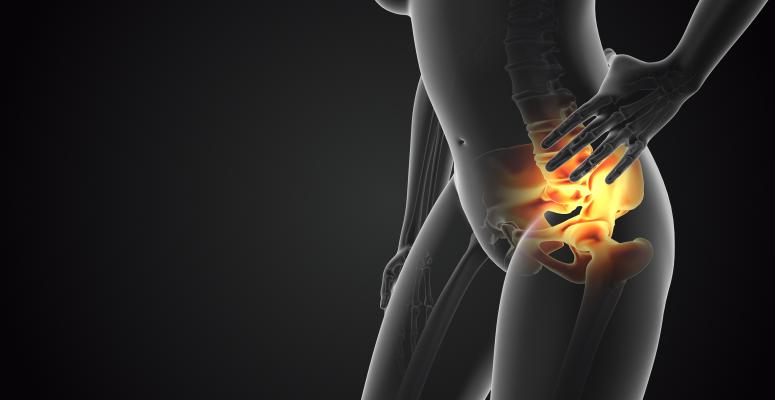
- Why do I have pelvic pain when I sneeze?
- What are some common causes of pelvic floor dysfunction?
- What other symptoms of pelvic floor dysfunction should I look out for?
- How can physical therapy help me with pelvic pain when sneezing?
- Alliance PTP can connect you with the physical therapy practice you need to relieve pelvic pain when sneezing
Aches, pains, sniffles and sore throats cause plenty of discomfort when you’re not feeling well. Some people dread cold and flu season for another reason. If coughing and sneezing causes you pelvic pain, you’re not alone. Both men and women can develop pelvic floor dysfunction for different reasons, and it can affect people in different ways. Along with pelvic pain when sneezing, pelvic floor dysfunction can cause general pelvic and abdominal pain, bladder control issues, muscle spasms, and more.
Pelvic health isn’t something we talk about often, so many people take it for granted. Those who have pelvic floor dysfunction know that it can make a big difference in your quality of life. Unfortunately, taboos and shame around these symptoms sometimes keep people from getting the help they need. As providers of pelvic floor therapy, we care about destigmatizing pelvic health issues. We want to make these conversations more approachable so you can take an active role in your own wellness and make more informed health care decisions.
In this article, we’ll discuss some common causes of pelvic floor dysfunction and how physical therapy can help.
Why do I have pelvic pain when I sneeze?
When you sneeze, your diaphragm and abdominal muscles contract. This puts pressure on your pelvic floor. If this causes you pain, you may have pelvic floor dysfunction, such as weakness or tightness in your pelvic floor muscles. Pelvic floor dysfunction is an umbrella term that covers symptoms from a variety of conditions. It can affect both men and women of different ages, and it can be caused by pregnancy, aging, medical conditions or a lack of conditioning. Physical therapy treatments can help people correct muscle weakness and imbalances that come with pelvic floor dysfunction and reduce their pain symptoms.
What are some common causes of pelvic floor dysfunction?
There are many reasons why people develop pain from a lack of muscle tone in their pelvic floor. Living a sedentary lifestyle, not getting enough physical activity, and carrying excess weight are often factors. People who have had a child may develop pelvic floor dysfunction during or after pregnancy. It can also be a result of traumatic injury or surgery. Pelvic floor dysfunction can be a chronic condition, but in most cases, it can be corrected with some physical therapy.
Many people associate pelvic floor therapy with women’s health conditions, but there are a few men’s health conditions that it can help with, too. Disorders that affect the bladder, bowel, uterus, prostate and nerves in the pelvic area can also cause muscle dysfunction. The muscles in your pelvic floor may not be receiving the signals that cue them to function, or they may be contracting in response to pain and dysfunction in pelvic organs. For example, women can develop a condition called pelvic organ prolapse, where the uterus, bladder or bowel bulge downward into the vagina. Interstitial cystitis is another common condition that causes bladder sensitivity and sometimes affects the pelvic floor muscles.
The following are 10 of the most common causes of pelvic floor dysfunction:
- Weakness or tightness in pelvic floor muscles
- Pelvic organ prolapse
- Changes in the pelvic floor during and after pregnancy
- Interstitial cystitis (bladder sensitivity)
- Medical procedures like surgeries
- Traumatic injuries
- Conditions that affect the bladder and bowel (such as IBS or cancers)
- Prostatitis
- Nerve damage
- Excess weight
What other symptoms of pelvic floor dysfunction should I look out for?
Pelvic pain when sneezing is just one of several possible symptoms of pelvic floor dysfunction. The pelvic region is connected to muscles in the lower back and the abdomen, so pain in any of these areas may be caused by pelvic floor dysfunction. It often causes problems with urinating or passing bowel movements and, for women, pain during sex. You may also notice a sensation of pressure or muscle spasms in the pelvic area.
If you’re experiencing pelvic pain when sneezing and you’ve had any health conditions that affect your pelvic organs or muscles, you may have pelvic floor dysfunction. A physical therapist who specializes in pelvic floor dysfunction can help you understand your condition and provide treatments to help relieve your symptoms.
If pelvic floor dysfunction is causing you pain when you sneeze, you may notice some of these other symptoms:
- Pain or pressure in the pelvic region, genitals or rectum
- Urinary symptoms, such as strong urges to urinate or painful urination
- Constipation or bowel strains
- Lower back pain
- For women, discomfort during sex
- Muscle spasms in the pelvis
How can physical therapy help me with pelvic pain when sneezing?
One of the first things your physical therapist will do is ask you questions about your symptoms and do some tests to gauge how your pelvic floor muscles are functioning. Patient education is an important part of pelvic floor physical therapy, so you’ll learn about pelvic health in general and about your specific condition. Based on their findings, your physical therapist will make treatment recommendations and work with you to create a personalized treatment plan.
Your treatments will mainly focus on toning and strengthening the muscles of the pelvic floor so you won’t feel as much pain in general or when you sneeze. This creates more support for the organs situated in the pelvic floor, such as the bladder, uterus, prostate and rectum. You’ll also learn techniques for relaxing tight muscles and releasing tension. You’ll have a better ability to control your pelvic floor muscles, so going to the bathroom will be easier.
A physical therapist with experience treating pelvic floor dysfunction can provide the following treatments to help reduce pain when sneezing and other symptoms:
- Manual therapy — Your physical therapist may use their hands to relax tight muscles and release tension stored in soft tissue with massage-like movements. Your PT will always make sure you have a good understanding of the treatment and ask for your consent before touching you.
- Therapeutic exercise and stretching — You may have heard of Kegel exercises for the pelvic floor. Kegels are just the beginning of the exercise and stretching techniques that can help you improve muscle tone and control in pelvic floor muscles. You’ll also strengthen your abdominal muscles and other muscle groups that support your pelvic organs.
- Relaxation techniques — As you learn about different muscles and gain more control, you’ll also learn techniques to relieve built-up tension.
- Postural exercises — The way you carry yourself affects your pelvic organs and muscles. You’ll develop an awareness of your posture and learn exercises you can use to check and improve your posture throughout the day.
- Electrical stimulation — When pelvic floor muscles are particularly weak and stiff, gentle electrical stimulation can help activate them for stronger contractions.
Alliance PTP can connect you with the physical therapy practice you need to relieve pelvic pain when sneezing
Ready to learn more about your own pelvic health and try some treatments to minimize pain when sneezing? Finding the right physical therapist is the first step. You’ll find plenty of options to choose from among the Alliance Physical Therapy Partners practices nationwide.
Our team can quickly put you in touch with one of our partner clinics near you, and their friendly and knowledgeable local staff can help you find care for your pelvic floor dysfunction. Some of your treatments will likely require you to see your physical therapist in person. However, Alliance PTP and many of our partners in most states are also able to see patients virtually.
Still have questions about what we and our partners can do for you? We’re ready to answer them and help you find the physical therapy you need.
Get Help at a Location Near You
